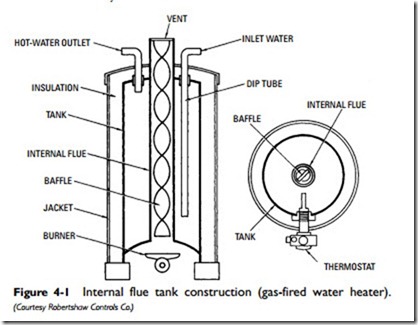Direct-Fired Water Heaters
A direct-fired water heater is one in which the water is heated by the direct combustion of a fuel such as gas, oil, or coal. The combustion flame directly impinges on a metal surface, which divides the flame from the hot water. This metal surface is quite often (but not always) the external wall of the hot-water storage tank. It serves as a convenient heat transfer surface.
A direct-fired water heater is easily distinguished from an indirect water heater (see Indirect Water Heaters later in this chapter), which uses an intermediate heat-conveying medium such as steam or hot water, and an electric water heater, which depends on an immersed electric heating element for its heat.
Automatic Storage Water Heaters
The underfired automatic storage heater in which a single tank is used for both heating and storing the water is the most common water heater used in houses, apartments and small commercial buildings. These heaters generally have a 30-, 40-, or 50-gallon storage capacity, although it is possible to purchase automatic storage heaters with capacities ranging from 70 gallons to several hundred gallons.
Automatic storage heaters are classified according to the place- ment of the flue. Using flue placement as a basis for classification, gas-fired automatic storage water heaters can be divided into the following three basic types:
1. Internal or center flue.
2. External channel flue tank.
3. External flue and floating tank.
The internal or center flue gas-fired water heater (see Figure 4-1) is very economical to manufacture, but proper flue baffling is required for good efficiency.
The external channel flue gas-fired water heater provides a much larger heating surface than the center flue. As shown in Figure 4-2, the entire bottom surface of the tank serves as the heat- ing surface. Heating is from the bottom of the tank, which acts to increase efficiency.
An even larger heat transfer surface is provided by the external flue and floating tank water heater illustrated in Figure 4-3. Both the full bottom and sides of the tank serve as heat transfer surfaces. The heat (and gases) passes around the storage tank and exits through the vent.
The tank and flue construction of oil-fired automatic storage water heaters is very similar to gas-fired types. The major difference between the two lies in the combustion chamber. In gas-fired water heaters, the burners are located inside the combustion chamber (see Figures 4-1, 4-2, and 4-3). In oil-fired water heaters, the oil burner is mounted externally, and the flames are shot into the combustion chamber (see Figure 4-4).
Additional information about automatic storage water heaters can be found in this chapter in the section Gas-Fired Water Heaters.

